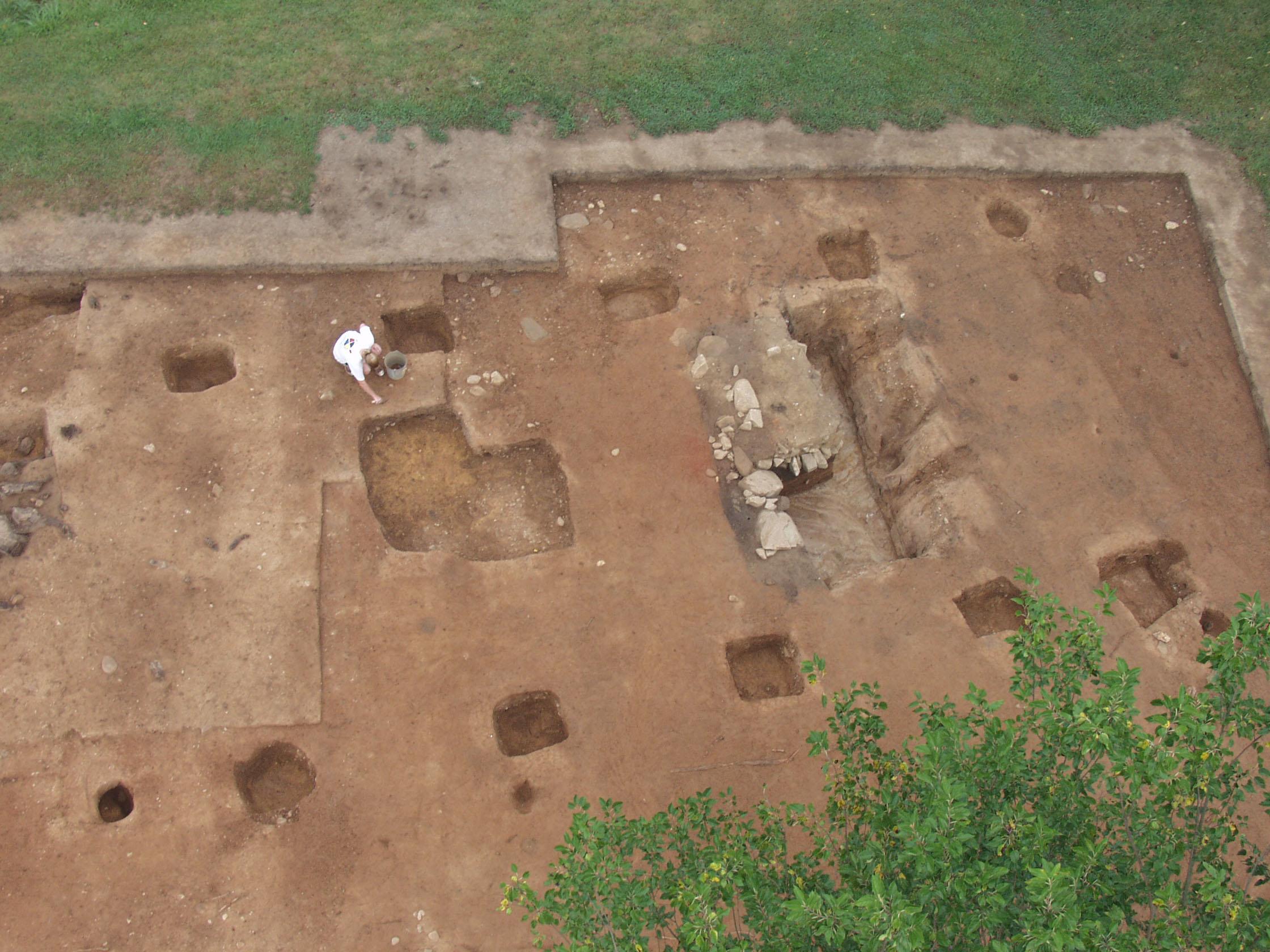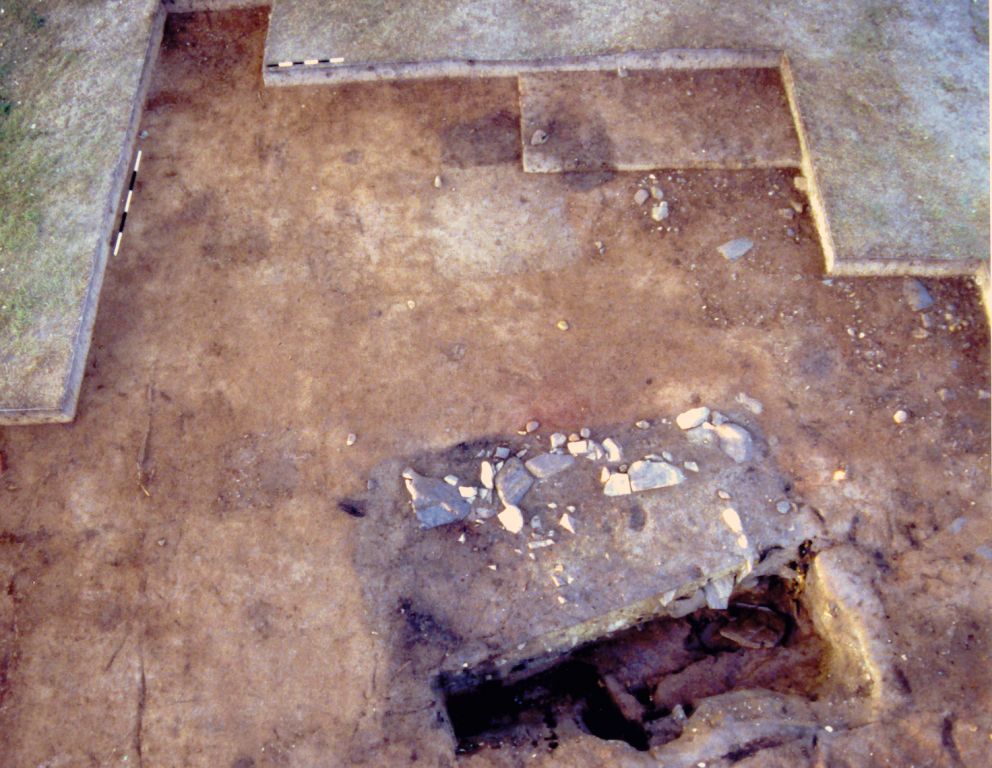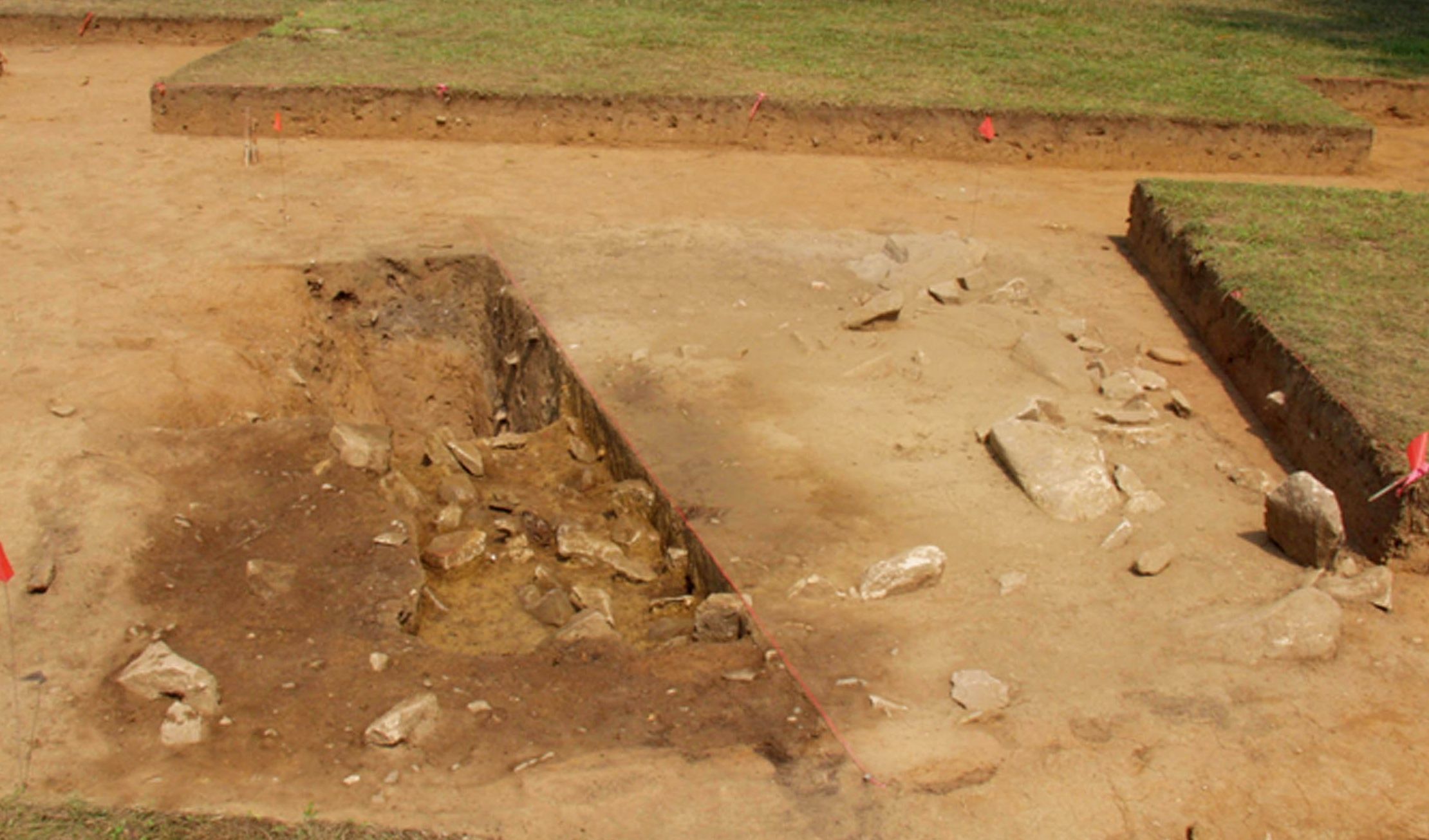Maurice Clark Site (44ST174)
Introduction
The Maurice Clark site (44ST174) is the dwelling associated with a small, 150-acre plantation located at what is
today called Ferry Farm in Stafford County, Virginia. The Maurice Clark site overlooks the Rappahannock River
opposite Fredericksburg and was excavated as part of an initiative to locate George Washington's childhood home.
Maurice (or Morris) Clark had acquired the property by 1710, building two structures (one a dwelling) and then
dying within six months. While Clark was not married, he did own the indenture of a white servant named Dennis
Linsy. Clark held no title or office, but he did own two tracts of land, livestock, and at least two horses by
the time of his death.
Clark left his dwelling plantation to Peter Waterson, but little is known about him or his household. Sometime
before 1727, Thomas Harwood and his wife, Margaret, acquired the property. That year, they conveyed the property
to William Strother. Both families included households with women and children, and these families were of the
same station in life as Clark and Waterson. By the time that William Strother died in 1733, the property comprised
"a very handsome dwelling house, 3 Store houses, several other convenient Outhouses and a ferry belonging to it"
(Muraca et al. 2011).
Ferry Farm, or the Home Farm as it came to be called, was occupied by the Washington family beginning in 1738 until
1772, when Mary Washington moved to Fredericksburg. The property was sold in
1776 to Hugh Mercer, who died the following year. The plantation was then rented out to Chatham Plantation
until it was sold to Chatham's owner, Judge John Coalter, in 1829. Ownership of Ferry Farm changed hands
several more times before returning to Chatham Plantation in 1847.
Archaeological Investigations
 Schnitting subsoil, Maurice Clark site (The George Washington Foundation)
Schnitting subsoil, Maurice Clark site (The George Washington Foundation)
The Maurice Clark site was excavated in 2002 and 2003 as part of an effort to identify George Washington's
boyhood home. A second series of excavations was undertaken in 2006 and 2007. These
investigations revealed that the Maurice Clark site, which dates ca. 1700–1730, pre-dated the Washingtons'
arrival at the property.
The aims of this research were multipronged, with particular emphasis placed on understanding the landscape
and material culture of small planters at the turn of the 18th century. Archaeologists used USGS coordinates to
establish a grid. Using 5-by-5 foot excavation units, the 2002 field team excavated a 1,275-square-foot block.
During the 2003 season, an additional 2,000 square foot block was excavated by flat shovel. A total of
131 5-by-5 foot excavation units were dug during these two seasons. Soils were either dry-screened through
¼-inch mesh or water-screened through window mesh. Samples from plowed soils and feature fill were taken for
flotation and submitted for soil chemistry and phytolith analysis.
The written and archaeological records suggest that the dwelling was built ca. 1700 and underwent substantial
renovation ca. 1720. The site appears to have been demolished and abandoned not long after that renovation.
The site includes two post-in-ground structures and several sealed contexts.
Features
The eight post holes that outline the roughly rectangular perimeter of the dwelling indicate that its measurements
were 20-by-30 feet. This frame structure would have been sheathed with clapboard, and would have included two ground
floor rooms, a wattle and daub fireplace and chimney at its south end, a loft, and several cellars.
 Maurice Clark dwelling (The George Washington Foundation)
Maurice Clark dwelling (The George Washington Foundation)
 Root cellar, Maurice Clark site (The George Washington Foundation)
Root cellar, Maurice Clark site (The George Washington Foundation)
 Cellar, Maurice Clark site (The George Washington Foundation)
Cellar, Maurice Clark site (The George Washington Foundation)
 Cellar excavation, Maurice Clark site (The George Washington Foundation)
Cellar excavation, Maurice Clark site (The George Washington Foundation)
One 4.5-by-6.5 foot root cellar was located 10 feet north of the hearth in the 20-by-20 foot large south room.
This feature was the original root cellar, measuring 2.0 feet below subsoil at its deepest. This pit appears not
to have failed but rather to have been abandoned soon after it was built. It was likely intentionally filled,
perhaps during the building's renovation ca. 1720.
Two discernible soil strata were recorded in this original root cellar. The first or top layer included clay
deposits containing "small flecks of brick and daub, fish bones and scales, pipe stems, eggshells, pewter,
and burnt oyster shell," while the second layer was a yellow brown sandy loam containing mainly charcoal and
brick flecks. Excavators also recovered daub, "fish scales and bones, eggshell, burnt oyster shell, pipe stems,
pipe bowl fragments, straight pins, lead casting waste, lead shot, and ceramics" (Muraca et al. 2011).
After this cellar was filled, it appears that a 5-foot-deep, bowl-shaped pit was dug in its filled-in center. This
bowl was filled with charred wood, brick, and sandstone associated with the chimney.
This now-filled south room cellar was replaced by a second, shallower root cellar built just north of it. This
square cellar measured 5.1 feet across and 1.0 feet below the base of plow zone at its deepest. Excavations of this
cellar uncovered two distinct layers of soil and a number of artifacts post-dating 1720. These include "early
ceramics, window glass, wine bottle glass, nails, and lithics" in the first or top layer and a large number of
charcoal and burnt faunal remains in the second (Muraca et al. 2011).
The previously noted wattle and daub chimney in the south room, like the nearby cellar, also failed rapidly and
was replaced by a more efficient model. The base of this stone chimney was erected atop the filled south room cellar.
However, these renovations did not last long, as the entire structure was demolished under William Strother's
ownership sometime after 1727.
A third and deeper root cellar measuring 13-by-10 feet across and 5 feet deep was located in the smaller north
room (itself measuring 20-by-10 feet). This cellar was likely used for storage in a room used as a workspace.
The north room cellar, however, failed rapidly after initial construction, as evidenced by its severely
eroded walls.
One 1.3-by-1.0 foot large structural posthole was uncovered on the north side of this third cellar. According
to Muraca et al. (2011), this posthole was likely dug to hold a wooden block support of a structural sill. Its contents included
yellow brown silty loam fill and "tobacco pipe stems, bottle glass, animal bones, plaster and mortar." The
artifacts recovered from the post hole suggest a construction date of post-1670. The post mold, measuring
1.0-by-0.9 feet and composed of a dark brown sandy silt fill, contained "bottle glass, white salt-glazed
stoneware (TPQ 1720) and mortar" (Muraca et al. 2011).
An additional eight structural post holes were recorded and excavated during this season, although only one
contained artifacts. These holes were evenly spaced at 9.5 foot intervals and appear to comprise the structure's
outline. Muraca et al. (2011) concluded that, given the spacing of the holes, their mostly rectangular plan
shape, and their similar depths, the builders used the pre-assembled sidewall construction technique to
raise the structure.
Artifacts
In total, 52,094 artifacts were recovered from the features and 131 excavation units at the Maurice Clark site.
Lithic debitage made up the majority of this number followed closely by bone fragments. A total of 4,373 ceramic
sherds and 3,045 tobacco pipe fragments were also recovered. Of the ceramic sherds, 39 distinct ware types were
identified. At 746 sherds, creamware was ubiquitous, followed by white salt-glazed stoneware (n=471), tin-glazed
earthenware (n=403), pearlware (n=365), whiteware (n=181), Rhenish blue and gray stoneware (n=164), slipware (n=123),
and porcelain (n=102). The refined earthenwares, including creamware, pearlware, whiteware, and other post-1730
materials, are associated with a Washington-period quarter housing enslaved laborers located just south of the Maurice Clark house,
and not with the Maurice Clark house.
Small finds include 4 beads, 1 curtain ring, 30 pieces of daub, 3 hinges, 3 keys, 9 locks, 25 nails, 28 tacks,
46 ammunition, 4 gunflint, 3 knives, 58 projectile points, 1 tool, 51 buttons, 10 cufflinks, 9 curlers, 4 horse
bits, 9 horse buckles, 8 horseshoes, 2 leather horse ornaments, 1 horse ring, 1 spur and 1 stirrup, 1 snuffer,
1 book hinge, 1 figurine, 12 pieces of hardware, 2 ornaments, 2 pots/pans, 1 seed, 3 toys, 6 lithic tools, 41
Native ceramic sherds, 122 sewing pins, 2 sewing scissors, 3 thimbles, 4 tobacco pipe sherds, 3 bottle seals,
6 European ceramic tableware sherds, 36 glass tableware sherds, 1 dead eye, 1 fish hook, 1 bale seal, 5 coins,
8 forks, 9 knives, and 4 spoons. Additional architectural artifacts associated with the early 18th-century
structure include one "large and sturdy lock," "hinges, pintles, and clenched nails," a small number of window
glass sherds, and plaster. A child's thimble was also recovered, indicating that Clark or one of the following
property tenants likely had at least one daughter and a wife.
Analysis of faunal remains revealed that 4,393 bones associated with the 18th-century occupation of the Maurice
Clark site were recovered during the first two field seasons (Hatch 2012). This analysis further revealed that
domestic species comprised 79% of the assemblage, while wild game accounted for 21%. The species most commonly
consumed were cattle (Bos taurus), wild boar (Sus scrofa), white-tailed deer (Odocoileus virginianus), and chicken
(Gallus gallus). These are just four of the 22 distinct species represented in the Maurice Clark site faunal
assemblage.
A total of 2,708 bone fragments were recovered from the pre-renovation features. This is considerably more than
the number of fragments (n=836) recovered from the post-renovation features, suggesting yet again that the
structure was not occupied for long after it was renovated.
References
Hatch, D Brad. 2012. A Report
on the Faunal Remains from the Maurice Clark Site (44ST174). On file, George Washington Foundation, Fredericksburg, VA.
Muraca, David, Paul Nasca, and Phil Levy. 2011.
Report on the Excavation of the Washington Farm: The
2002 and 2003 Field Seasons. On file, George Washington Foundation, Fredericksburg, VA.
What You Need To Know To Use This Collection
The Maurice Clark artifacts were imported directly into the database without further evaluation.
Further Information About the Collection
The Maurice Clark collection is owned by George Washington Foundation in Fredericksburg. For more information
about the collection and collection access, contact Melanie Marquis, Archaeology Lab Supervisor, at 540-370-0732;
email healy-marquis@gwffoundation.org.
To Download Data
Data and a variety of other resources from this site are available for download. To download data,
please go to the Downloads page.